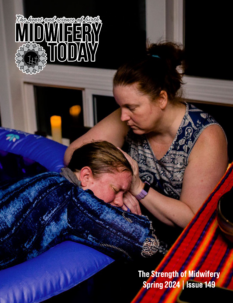
Who Benefits from Training Traditional Midwives?
Editor’s note: This article first appeared in Midwifery Today, Issue 91, Autumn 2009.
Subscribe to Midwifery Today Magazine
The answer to this question may appear obvious at first. Women and their babies benefit—right? “Of course…perhaps…depends…maybe… in the long run,” and other qualifiers apply. The title does not ask about “What is the advantage of training midwives,” nor does the verb “trained” appear in the question. And, we won’t tackle the study results of so-called “training programs” for traditional midwives in poor countries.(1) Those of us who have trained traditional midwives are aware of the political, social and logistical difficulties of training in low-resource countries—the least of which is the level of literacy. Perhaps we could start by discussing who does the training and how they benefit; because selecting which young women are to be trained as “skilled birth attendants,” where and how they will be trained, and what criteria will be required for graduation really determines who will benefit from the training process.
As we all know, the history of midwifery has been a long struggle between a male-dominated priesthood and its subsequent system of organized medical interventions, and a women’s community-based network of helping and healing.(2) Also, as has been documented over the years in this magazine, training traditional midwives is not only morally correct and socially just, it is sometimes the only way to get health care to poor, rural or urban, indigenous women in many countries around the world.
Everyone—from the doctors at the Ministry of Health offices in capital cities, to the World Health Organization (WHO), to agencies like the United States Agency for International Development (USAID) and the United Kingdom’s Department for International Development (DFID), which fund organizations to train so-called “Traditional Birth Attendants”—agrees that training midwives is the best way to decrease that stubborn and stuck number that continues to disrespect all that expensive training: 580,000. That’s over a half million maternal deaths every year.(3) After all the years of training, all the programs invented, and all the millions of dollars spent, that number has never diminished. Every minute of every day somewhere on this Earth, 360 women become pregnant—with 190 of those pregnancies unplanned or unwanted and 110 with a complication; 40 women have an unsafe abortion; and one woman dies.(4) Every minute. With or without a “skilled birth attendant,” as we’re now labeled.
The main thing I have learned from training traditional midwives is the importance of connection. All women naturally know about connections—it is in our genetic code.(5) Under stress we connect with other women for strength in numbers, we gather the children, we comfort the lonely and sick, we attend in childbirth (we don’t “deliver the baby”). We connect through the gift of trust. We trust in birth, we trust in ourselves and our abilities to attend a woman, and we connect with the presence of expert and timely medical intercession in case of an emergency.
So, how do we connect traditional midwives with the medical systems they need for emergency interventions? We can train them to recognize danger signs, intervene appropriately and transport—which are all well and good, if the transport exists and if a hospital has trained personnel, correct medications and other resources to intervene and save a life. Unfortunately, when the woman and her traditional midwife (who is the authority on birth and health in her community) arrive at the referral hospital, they enter another planet—and everyone from the receptionist to the surgeon is the authority on this planet. These authorities frequently don’t speak the same language as the midwife or the woman, don’t know the cultural rituals, and don’t really care. They want to save a life, “deliver” a baby, and move on to the next patient. The midwives, nurses and doctors in Planet Hospital have the authoritative knowledge on health and illness care.
Authoritative knowledge is all about accountability in a community of practice—not that the knowledge is correct, but that it matters.(6) Just as certain medical practices based on bad habits or fear may be incorrect, it still matters that other professional health providers believe those practices are correct.
Take, for example, the hospital rituals used every day that become routine: IV insertion, Pitocin drips, fetal monitors, episiotomies or any of the other common interventions that occur in hospitals all over the world. The woman, who until this moment may have trusted her body and her traditional midwife, now must transfer her trust to a complete stranger who may or may not be sympathetic to her wants and needs. This purpose-filled separation makes her even more dependent on the professional provider with his authoritative knowledge.
In her book on authoritative knowledge, Robbie Davis-Floyd discusses how hospital rituals fill important psychological needs:
- The individual need of every hospital staff person for constant confirmation of the rightness of their technological interventions and for ways to cope with something not really under their control, which threatens their technocratic model of birth.
- The needs of the woman who is giving birth for reassurance when faced with the unknown, for “official” recognition by society’s designated authorities on birth, and for official confirmation of her belief system.
- The important need of the wider culture to ensure the effective socialization of its citizens and thus society’s perpetuation.(7)
How can simple hospital rituals assure “socialization of citizens”? Because vertical authority perpetuates patriarchy. Think about how rituals in any context promote and value conformity within a group. The whole point is control and conformity. Conformity helps everyone relax around an unknown factor, and they are comforted to count on a vertical line of authority. Thus, training programs for traditional midwives written and realized by university-trained professionals provide a benefit to the professionals’ agenda: control, conformity and authority.
With the magic words “Hospital Policy,” two powerful messages appear: First, that the hospital has the right to separate the woman from her trusted companion, thus holding higher authority than the family, and second, that the laboring woman belongs to the hospital institution and not to her family unit. Can you imagine a traditional midwife understanding or adhering to any of these rituals? Why would she? She knows that the mother is the authoritative person in the room giving life. While the traditional midwife brings ritual to the birthing scene, her procedures are meant to adjust elemental forces around this woman and her baby, to smooth the journey.
Just as the traditional midwife and her clients mistrust hospital rituals and personnel, those “skilled attendants” mistrust the midwife and her authoritative knowledge. They move in different communities of practice. Our goal, as trainers of traditional midwives, should be to find bridges to connect those two distinct communities, because they both matter to mothers. Healthy mothers and babies are our first priorities, not ritual or habit.
Unless we learn to work within the public health system, we will always be reacting to the whims of whichever physician happens to be in the Ministry of Health during that rotation who dictates the criteria for training traditional midwives. That doctor is seen in his community of practice as the authority regarding maternal and newborn health care. His community of practice makes the protocols and legislates the laws for everyone else. The problem is that, in most countries, the laws of medical practice have nothing to do with how, where or with whom a woman chooses to give birth.
Instead of challenging the medical legal authority, we midwives need to get some public health expertise and come to the table with fresh training ideas based on sociology, anthropology, psychology and marketing, if we want to influence policy to save lives. Perhaps we should add civil engineering to our toolbox—to build bridges to the future.
References:
- Sibley, L., and T.A. Sipe. 2004. What can a meta-analysis tell us about traditional birth attendant training and pregnancy outcomes? Midwifery 20(1): 51–60.
- “A Brief History of Midwifery.” StudentMidwife.net. www.studentmidwife.net/educational-resources-35/midwifery-history-43/662-a-brief-history-of-midwifery.html. Accessed 20 May 2009.
- World Health Organization. Maternal Mortality in 2005: Estimates developed by WHO, UNICEF, UNFPA and The World Bank. 2007. http://whqlibdoc.who.int/publications/2007/9789241596213_eng.pdf. Accessed 20 May 2009.
- White Ribbon Alliance for Safe Motherhood. www.whiteribbonalliance.org. Accessed 20 May 2009.
- Taylor, S., et al. 2000. Behavioral Responses to Stress in Females: tend-and-befriend, not flight-or-flight. Psychological Review. 107(3): 411–29.
- Davis-Floyd, R., and C. Sargent, eds. 1997. Childbirth and Authoritative Knowledge—Cross-cultural perspectives. Berkeley, California: University of California Press.
- Ibid.


















